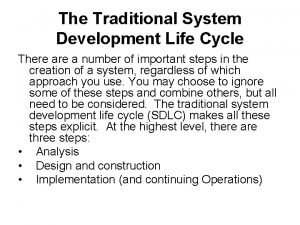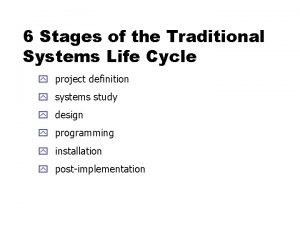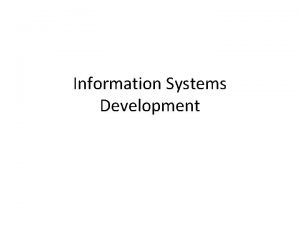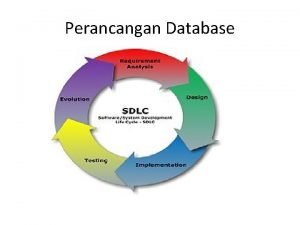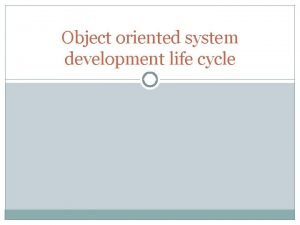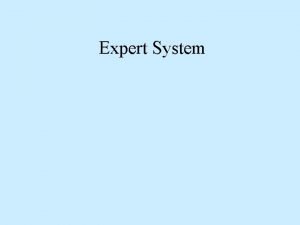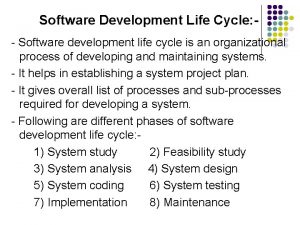The Traditional System Development Life Cycle There a







- Slides: 7

The Traditional System Development Life Cycle There a number of important steps in the creation of a system, regardless of which approach you use. You may choose to ignore some of these steps and combine others, but all need to be considered. The traditional system development life cycle (SDLC) makes all these steps explicit. At the highest level, there are three steps: • Analysis • Design and construction • Implementation (and continuing Operations)

The Traditional System Development Life Cycle I. Analysis 1. Initiation (e. g. , an RFP) 2. Feasibility study • • Go? No go? Technical – can we build it? Economic – should we build it? Operational – if we build it, will it be used? Schedule – will it be ready in time? 3. Requirements definition 4. Specifications 5. Project plan

The Traditional System Development Life Cycle II. Design 6. Logical design (i. e. , the external view) 7. Physical design (i. e. , the internal view) 8. Coding (or code acquisition) 9. Testing

The Traditional System Development Life Cycle III. Implementation 10. Documentation – ouch! This should have been done all along! 11. Conversion • • Direct Parallel Pilot Phased 12. Training – both initial and continuing • • • Users I/S staff Management 13. Installation

The Traditional System Development Life Cycle IV. Operations 14. Production 15. Post-implementation audit 16. Maintenance

The Traditional System Development Life Cycle Why conduct a post-implementation audit? To answer these four questions: 1. Did we deliver the system that we promised to deliver; it is working as promised? If not, we should fix it. 2. If it is working as promised, is the user harvesting the benefits; i. e. , achieving the economic results that he promised to achieve? If not, he should be made to do so. 3. Are there new features that should be added to the system? 4. What have we learned from this project that can help us with how we do projects in the future?

The Traditional System Development Life Cycle What is maintenance? “It is post-implementation software development, designed to ensure the continued effectiveness of the software in question. ” There are three types of maintenance: 1. Corrective 2. Adaptive 3. Perfective How should maintenance be managed? 1. “Cradle-to-grave”; those who built it, maintain it. 2. Separate maintenance department. 3. Outsource the maintenance to a third party.
 Traditional system life cycle
Traditional system life cycle Traditional system development life cycle
Traditional system development life cycle Traditional systems development life cycle
Traditional systems development life cycle Perancangan basis data secara konseptual
Perancangan basis data secara konseptual Object oriented development life cycle
Object oriented development life cycle The most creative and challenging phase of sdlc is
The most creative and challenging phase of sdlc is Expert system development lifecycle
Expert system development lifecycle Identify the correct sequence of edlc.
Identify the correct sequence of edlc.
